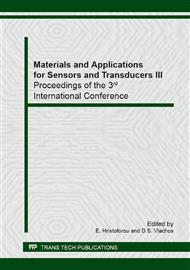p.215
p.219
p.223
p.227
p.231
p.235
p.239
p.243
p.247
Effect of Crack Formation under Elongation in Carbon Nanotube Networks Embedded in Polyurethane
Abstract:
A highly deformable composite composed of a network of electrically-conductive entangled carbon nanotubes embedded in elastic polyurethane for sensing tensile deformation by changes in strain has been prepared. The testing has shown that the composite can be extended as by much as 400 % during which the electrical resistance increases more than 270 times. The high strain sensing can be attributed to the network cracking upon extension. To understand the cracking mechanism and explain the resistance change, the structural changes of networks made of pristine carbon nanotubes (as well as functionalized multi-walled) were examined. The microscopic observation of crack formation and resistance change of the networks correlates well with the amount of cracking.
Info:
Periodical:
Pages:
231-234
Citation:
Online since:
April 2014
Authors:
Price:
Сopyright:
© 2014 Trans Tech Publications Ltd. All Rights Reserved
Share:
Citation:


